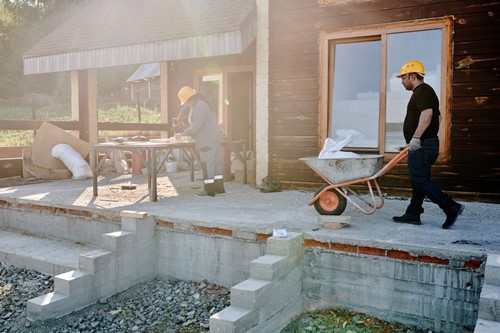
In both existing homes and new construction, there are several common types of foundations for houses. Each has their advantages and disadvantages, including specific maintenance requirements and climate-specific considerations.
Whether you’re building a new home or want to learn more about how to care for your existing home, it’s worth exploring the three major types of foundations used for houses:
Basement foundations are essentially holes dug beneath the house, matching most or all of the ground-level square footage. Builders use concrete footings around the edge of the basement space as a frame for the foundation, then follow with beams, walls and a concrete slab at the bottom.
Basement foundations can add extra living space to the home, potentially doubling the square footage if finished. Otherwise, unfinished basements serve as valuable storage space and shelter in case of extreme weather.
Concrete slab foundations are made of a simple, flat layer of concrete situated slightly below the surface of the ground. This is one of the simplest foundation types to install, involving a wire mesh and reinforcing bars within the concrete for extra stability.
Slab foundations are best for warmer regions, as frozen ground can cause cracks and shifts in the concrete. However, in the right conditions, a slab foundation will not develop weak spots or crumble over time.
Crawl space foundations have characteristics of both a basement and a slab foundation. They’re built using small concrete footings called stem walls, which create a slightly elevated space beneath the home. While you can’t use a crawl space as living space, it can be perfect for storage and access to plumbing or electrical wiring.
Crawl space foundations can help keep the home safe from flood damage, earthquake damage and termites. One disadvantage of this foundation type is the vulnerability to mold, mildew and pests who might like to make the shelter their home.
There are other types of foundations, like wood foundations and pier foundations, which are typically more specific to certain regions and types of home. There are also variations of the foundations found in this article, such as slab on grade foundations and daylight basements.
Regardless, the more you know about these three common types of concrete foundation, the more prepared you’ll be to take care of your own - whether in your current home or brand-new construction.

For over 25 years, Mike Johnson, has help Buyers and Sellers in Greater New Haven, and across the state turn their dreams into reality. TAJ REAL ESTATE, LLC is a full service firm specializing in Short Sale, First Time Home Buyers, Sale and marketing of existing Home and Condos, Rentals, FHA 203K Sale and Renovation of Distress Properties, and Investor Purchase.
Mike Johnson is a graduate of Fairfield University, and a resident of Connecticut for over 38 years. He served on the Board of Directors for Hill Health Corporation from 1976 to 1984, has served on the Professional Standard Committee of the Greater New Haven Board of Realtors for over 8 years, served as Board of Directors for that organization from 2009-2012, and on the Farmington Canal Committee for over 10 years.
Mike possesses a high degree of knowledge, experience and integrity, and strives for excellence, as such creating a reputation second to none. Whether your Home is under water (owing more than the mortgage balance), or behind on your mortgage and facing foreclosure, your solution is only a phone call away. Pick up the phone and put your troubles in the hands of a experienced Realtor.